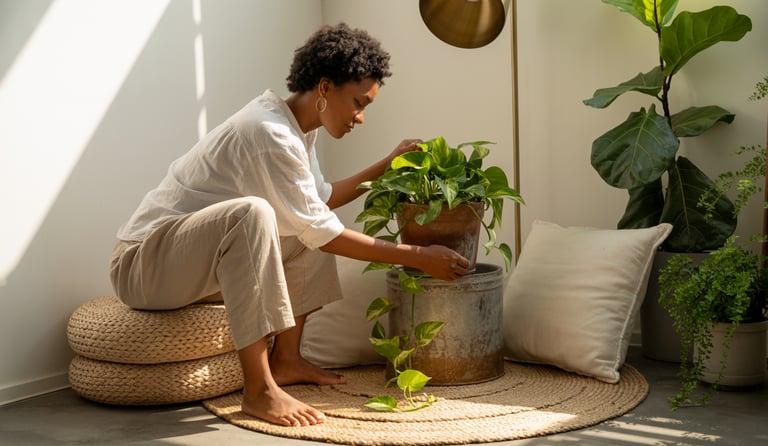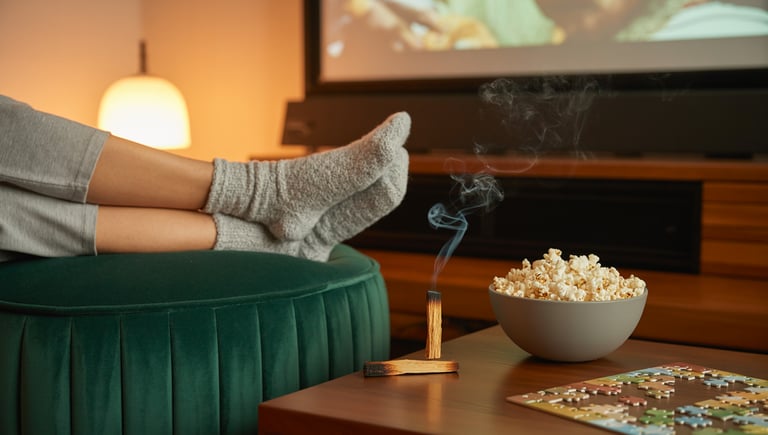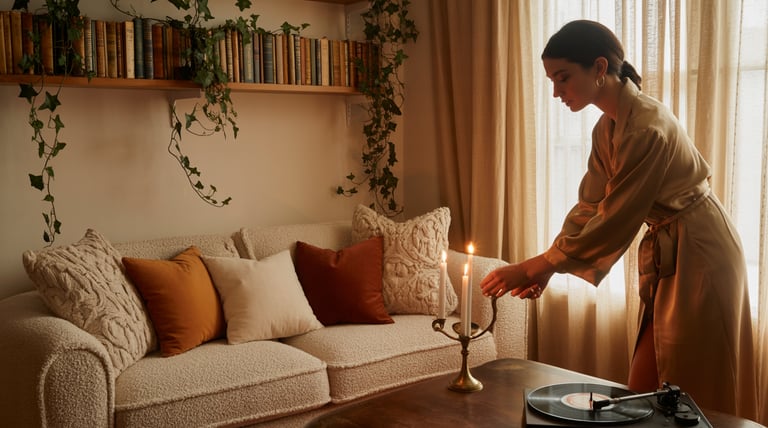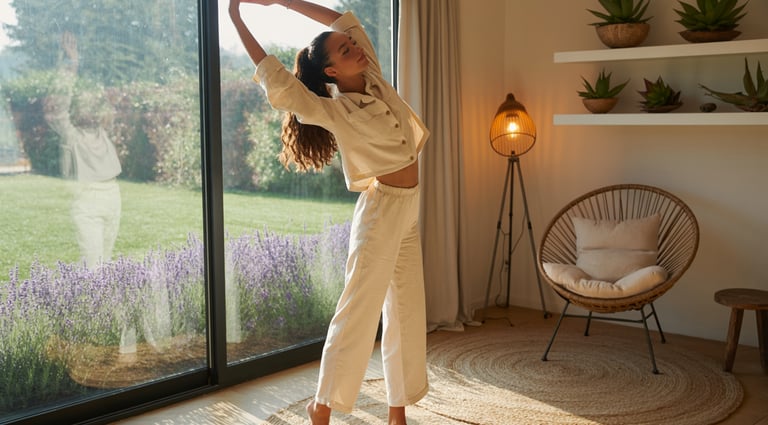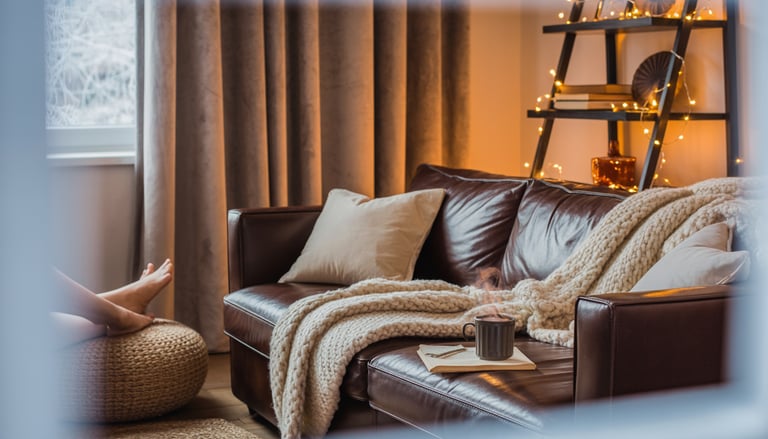Cozy Living Rooms That Invite Rest, Healing & Connection
In this soulful guide, we’ll show you how to style a cozy living room that radiates healing energy, intentional beauty, and everyday inspiration.
HOME DECORSELF-CARE AND WELLNESS
FONNI
5/16/202511 min read
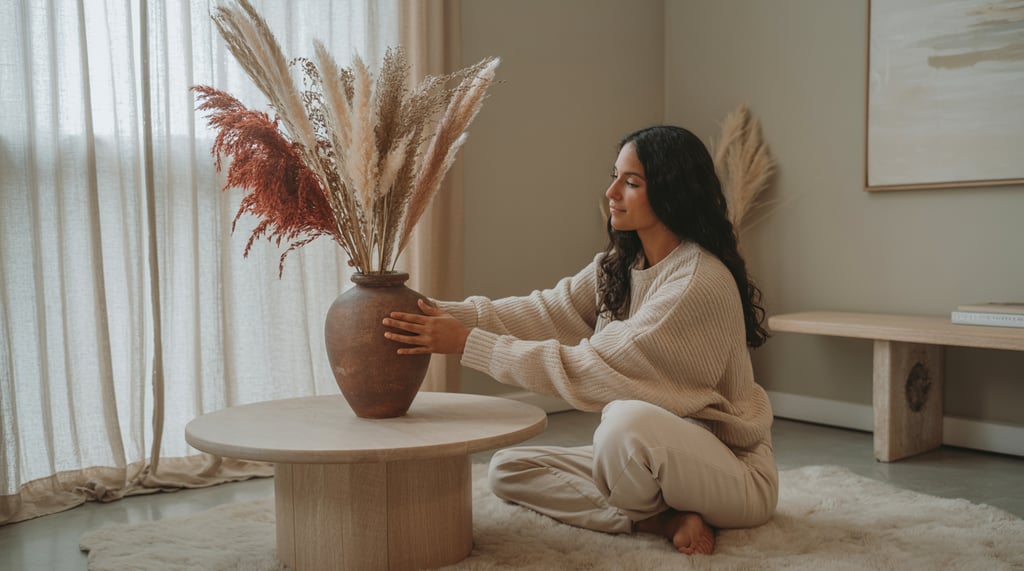

The content on this site was created with the help of AI. LOVEOWE LLC participates in the Amazon Services LLC Associates Program by linking to Amazon.com and other affiliate programs. This means I may earn a small commission—at no extra cost to you—when you make a purchase through links on this site. All opinions are my own. Learn more click here. Thank you for your support!
Imagine stepping into a living room where every detail whispers comfort and warmth. It's a place where you can curl up with a good book or a warm cup of tea. For me, transforming my living room into such a space has been a journey of self-care and mindfulness.
It's not just about rearranging furniture; it's about creating an atmosphere that nurtures well-being and fosters connection. A cozy living room is where we unwind, reflect, and share meaningful moments with loved ones.
As we explore the elements that make a living room cozy, we'll look at ways to support rest, healing, and connection. By incorporating softer lighting, layered textures, and personal touches, we can turn our living rooms into havens. These havens promote relaxation and togetherness.
The Psychology of Cozy Spaces
Our surroundings are key in shaping our emotional state, making the psychology of cozy spaces essential in home design.
Studies reveal that our environment greatly affects our mood, stress, and wellbeing. A cozy living room, then, is more than a personal preference. It's a space designed to foster relaxation and comfort.
How Environment Affects Mood and Wellbeing
The environment we surround ourselves with can either uplift or dampen our mood. Lighting, color, and texture all impact how we feel in a space.
Natural light exposure can boost serotonin levels, improving mood.
Soothing colors like blues and greens can promote relaxation.
Comforting textures from fabrics and furniture can enhance feelings of security.
By grasping these elements, we can craft a living room that invites and nurtures our mental and emotional health.
Essential Elements of a Cozy Living Room
A cozy living room is where beauty meets comfort. It's a space that looks great and feels even better. It invites you to relax and unwind.
Balancing Aesthetics and Functionality
Creating a cozy living room decor is about finding the right balance. It's about designing a space that looks stunning and feels welcoming.
Start by choosing furniture that's both stylish and comfortable. Opt for plush sofas and armchairs. They should look good and feel even better.
Creating Layers of Comfort
Adding layers of comfort is key to a cozy living room. Use throw blankets, rugs, and pillows to add texture. These elements make the room feel warm and inviting.
Layer different lighting sources to enhance the ambiance. Table lamps and floor lamps can create a cozy glow. Adjust the lighting to match the time of day or activity.
Incorporating Personal Touches
Personal touches make a living room truly special. Display family photos, heirlooms, or personal collections. These items add warmth and personality to the space.
By adding these personal touches, you create a cozy living room. It's not just beautiful; it's deeply personal and inviting.
How to Create Cozy Living Rooms That Invite Rest, Healing & Connection
To craft a welcoming space, we must first define our vision. This involves understanding what coziness means to us. We then need to figure out how to embody that in our living room.
Defining Your Vision for the Space
Defining your vision begins with identifying the feelings and experiences you desire in your living room. Do you envision it as a space for family bonding, a retreat for reading, or a haven for relaxation? Clarifying your goals will guide your design decisions.
Assessing Your Current Living Room
Start by taking stock of your current living room's layout, furniture, and décor. Reflect on what's working and what areas need improvement. This assessment will help you understand what you're working with and what changes are needed to achieve your cozy living room vision.
Planning Your Cozy Transformation
With your vision in mind and an understanding of your current space, it's time to plan your transformation. This involves several key steps:
Setting a Budget: Determine how much you're willing to spend on your cozy living room makeover.
Creating a Timeline: Establish a realistic timeline for completing your project.
Prioritizing Elements: Decide which elements are most important to achieving your cozy living room, such as comfortable seating, soothing colors, or warm lighting.
Setting a Budget
Setting a budget helps you focus on what's truly important. It ensures that your project remains financially manageable.
Creating a Timeline
A timeline keeps your project on track. It allows you to break down larger tasks into manageable chunks.
Prioritizing Elements
By prioritizing elements, you can focus on the most impactful changes. This will bring your vision to life, such as incorporating healing room décor tips.
By following these steps, you can create an inviting living room atmosphere. This atmosphere promotes rest, healing, and connection.
Selecting the Perfect Color Palette for Comfort
The color palette you choose greatly impacts your living room's ambiance, turning it into a sanctuary for relaxation and connection. Exploring colors reveals how tones and hues can shape our mood and wellbeing. It's vital to grasp this relationship.
Warm vs. Cool Tones and Their Effects
Warm tones, such as oranges, reds, and yellows, foster a cozy, inviting atmosphere. They evoke feelings of warmth and comfort. In contrast, cool tones like blues, greens, and purples induce calmness, promoting relaxation and serenity. Knowing these effects helps in selecting a palette that matches your desired ambiance.
Color Psychology for Relaxation
Color psychology is key in crafting a relaxing environment. Soft, muted colors tend to relax us, while bright and bold colors stimulate energy. For a cozy living room, soft colors that encourage unwinding and calmness are ideal.
Creating Color Harmony in Your Space
Color harmony is achieved by choosing colors that complement each other, creating a visually appealing and balanced atmosphere. The 60-30-10 rule is a useful guideline. It suggests 60% of the room should be a dominant color, 30% a secondary color, and 10% an accent color. This balance fosters a harmonious, inviting space.
Furniture Arrangement for Connection and Conversation
Furniture arrangement transcends mere placement; it crafts an environment that nurtures connection and conversation. As we curate our living spaces, we must ponder how layout impacts our interactions and comfort levels.
Creating Conversation Areas
Designing conversation areas in your living room is vital for fostering meaningful dialogue. To do this, arrange furniture to encourage face-to-face interaction. Opt for circular or U-shaped setups.
Position seating to foster conversation.
Define the conversation space with area rugs.
Ensure traffic flow doesn't disrupt the area.
Balancing Intimacy and Openness
Achieving a balance between intimacy and openness is essential for a well-designed living room. Arrange furniture to create snug nooks while maintaining an open feel.
For example, a sectional sofa can foster a cozy vibe while keeping the room airy.
Furniture Selection for Maximum Comfort
Choosing the right furniture is critical for a comfortable, inviting living room. Let's examine some key pieces to consider.
Choosing the Right Sofa
The sofa is the living room's focal point. When selecting a sofa, consider room size, seating capacity, and style that complements your decor.
Accent Chairs That Invite Relaxation
Accent chairs enhance seating and create cozy reading or conversation spots. Seek out chairs with plush cushions and supportive backs.
Coffee Tables and Ottomans
Coffee tables and ottomans serve both practical and decorative roles. They offer surfaces for drinks and snacks and also function as footrests or extra seats.
Lighting Strategies for a Restful Atmosphere
A well-designed lighting plan is essential for transforming your living room into a restful retreat. Lighting can significantly influence the ambiance of your space, making it either a haven for relaxation or a source of discomfort.
Layering Different Light Sources
Layering different light sources is a key strategy for creating a restful atmosphere. This involves combining various light types, such as overhead lighting, table lamps, and floor lamps, to achieve a balanced and versatile lighting scheme. By doing so, you can adjust the lighting to suit different activities and moods.
The Impact of Natural Light
Natural light has a profound impact on our mood and wellbeing. Maximizing natural light in your living room can enhance the sense of restfulness and connection to the outdoors. Consider using sheer curtains or blinds to control the amount of natural light entering your space.
Selecting Fixtures That Create Ambiance
The right lighting fixtures can greatly enhance the ambiance of your living room. Consider using a mix of lighting types to create a cozy atmosphere.
Table and Floor Lamps
Table and floor lamps are excellent for creating pools of warm light that invite relaxation. Choose lamps with soft shades to diffuse the light and add warmth to your space.
Candles and Fairy Lights
Candles and fairy lights can add a soothing ambiance to your living room. They provide soft, warm light that can help create a restful atmosphere, perfect for unwinding after a long day.
Dimmer Switches and Smart Lighting
Installing dimmer switches or smart lighting systems allows you to adjust the lighting levels to suit your needs. This flexibility is key to creating a restful atmosphere, as it enables you to tailor the lighting to different times of day and activities.
Textiles and Textures That Promote Healing
Transforming our living rooms into havens of rest and healing is essential. The role of textiles and textures is critical in this transformation. They provide a sensory experience that significantly impacts our emotional and physical wellbeing. By selecting and layering different textiles and textures, we can create a space that feels comforting and promotes healing.
Selecting Fabrics That Comfort and Soothe
The fabric choice greatly influences a room's coziness and healing properties. Opt for soft, breathable fabrics like cotton, linen, and bamboo for upholstery and bedding. These materials are gentle on the skin and help regulate body temperature, fostering a restful environment.
When choosing comforting fabrics, look for:
Softness
Breathability
Natural fibers
Durability
The Art of Layering Textiles
Layering different textiles adds depth and visual interest to a room, while also increasing comfort. This can be done by combining throw blankets, pillows, and rugs in various textures and patterns. The goal is to achieve a balance that creates a harmonious and inviting space.
For instance, layer:
A plush area rug over a hardwood floor
Soft throw blankets over a sofa or armchair
Pillows in different textures and patterns
Incorporating Natural Materials
Adding natural materials to your living room enhances warmth and coziness. Materials like wood, stone, and woven fibers introduce an organic feel, fostering a connection to nature.
Ways to incorporate natural materials include:
Using wooden furniture or accents
Incorporating stone or brick elements
Adding woven baskets or natural fiber rugs
Incorporating Nature for Tranquility and Wellness
Nature profoundly impacts our wellbeing, making it essential to integrate it into our living spaces. By bringing the outdoors in, we can craft a more serene and restorative environment. This environment promotes relaxation and lessens stress.
Houseplants That Purify and Calm
Houseplants are a simple yet effective way to bring nature into your living room. They not only purify the air but also have calming effects on some species.
Low-Maintenance Options for Beginners
For beginners, starting with low-maintenance plants like snake plants and ZZ plants is wise. These plants are easy to care for and can thrive in various lighting conditions.
Placement for Maximum Impact
To maximize the impact of your houseplants, place them in areas you frequently see. This could be on a coffee table or side table.
Natural Elements and Biophilic Design
Incorporating natural elements like wood, stone, and plants into your decor through biophilic design can also enhance tranquility. This design approach aims to reconnect us with nature. It promotes a sense of calm and wellbeing.
Creating Mindful Spaces Within Your Living Room
Creating a mindful space in your living room is a key step towards wellness. It allows us to pause and reconnect with ourselves. A mindful living room acts as a sanctuary, nurturing both body and mind, leading to overall wellbeing.
Designated Areas for Reflection and Meditation
Designating areas for reflection and meditation is essential in creating a mindful living room. It could be a simple corner with a cushion or a meditation chair. Or, it might be a dedicated meditation room. The goal is to create a space that encourages quiet contemplation.
Reducing Visual Clutter for Mental Clarity
Visual clutter can greatly affect our mental clarity. Reducing clutter is more than just tidying up. It's about creating a thoughtful, curated environment. This can be achieved through smart organizational solutions and minimalist decor.
Organizational Solutions
Organizational solutions help keep your space clutter-free. Use storage units that are both functional and visually appealing. For instance, storage ottomans or coffee tables with hidden storage can keep things tidy while maintaining a serene atmosphere.
Minimalist Approaches to Decor
Embracing a minimalist decor approach also contributes to a clutter-free, mindful space. This means choosing a limited color palette, simple patterns, and decor with purpose or personal significance. Such a space is calming to the eyes and rich in meaning.
Technology Balance in a Restorative Space
Technology can be both a blessing and a curse in creating a cozy living room. It brings convenience and connectivity but can also distract and stress us out.
Creating Tech-Free Zones
Designating tech-free zones in your home is a great way to promote relaxation. By setting aside areas or times for no technology, you create a more peaceful space. For example, making your bedroom tech-free can greatly improve your sleep.
Integrating Technology Mindfully
When technology is used wisely, it can make your space cozier. This includes smart home features that adjust lighting and temperature for comfort. It's about using technology in a way that meets your needs without overwhelming you.
Hiding Cords and Equipment
Part of using technology wisely is hiding cords and equipment. This keeps your space clutter-free and visually appealing. Cable organizers or hiding devices behind furniture can help achieve this.
Smart Home Features That Enhance Coziness
Smart home features, like voice-controlled lighting and thermostats, can greatly enhance your living room's coziness. They let you adjust the ambiance easily, making your space more comfortable and relaxing.
Seasonal Adjustments for Year-Round Coziness
As seasons shift, our homes can greatly benefit from adjustments to maintain coziness all year. Intentional changes with the seasons can keep your living room inviting and comfortable, regardless of outside weather.
Summer Strategies for Cool Comfort
In warmer months, aim for a cool, breezy living room atmosphere. Achieve this through:
Lightweight textiles such as cotton or linen
Breezy elements like fans or open windows
Lightweight Textiles and Breezy Elements
Switching to lightweight fabrics for upholstery, curtains, or throw blankets significantly impacts your living room. Opt for breathable materials that promote airflow, ensuring cool comfort.
Color Adjustments for Warmer Months
Adjust your color palette to lighter, brighter summer tones for enhanced comfort. Pastel shades or whites can create a refreshing ambiance.
Winter Warmth and Holiday Transitions
With winter's arrival, focus on creating a warm, cozy atmosphere. Layer for maximum coziness and add festive touches that complement the space.
Layering for Maximum Coziness
Layering different textures and fabrics adds depth and warmth. Combine plush throw blankets, soft rugs, and warm lighting for a cozy retreat.
Festive Touches That Don't Overwhelm
When decorating for holidays, balance festive cheer with cozy comfort. Add decorations thoughtfully to enhance warmth without cluttering the space.
Conclusion: Embracing Your Cozy Living Room Journey
Our journey through cozy living rooms reveals that coziness transcends physical space. It's about crafting an environment that supports rest, healing, and connection. By integrating the discussed elements, you can design a welcoming living room that boosts your wellbeing.
Your cozy living room journey is deeply personal and continuous. It involves making thoughtful choices to enhance comfort and peace. Every small adjustment can profoundly affect your space's ambiance.
We urge you to apply the insights and ideas from this article to create a sanctuary in your living room. This effort will significantly improve your quality of life, embracing coziness fully.
